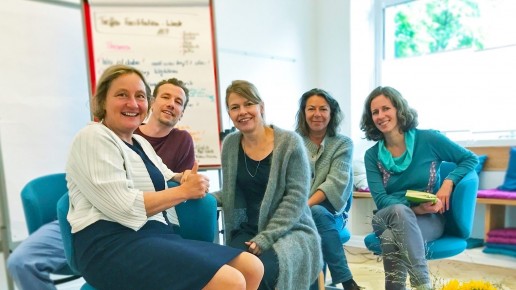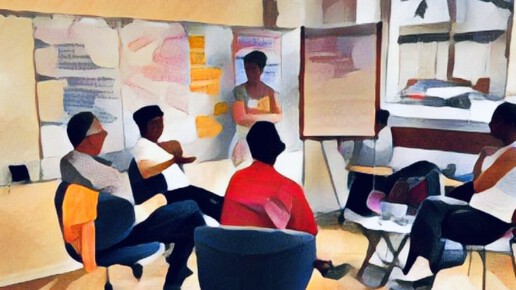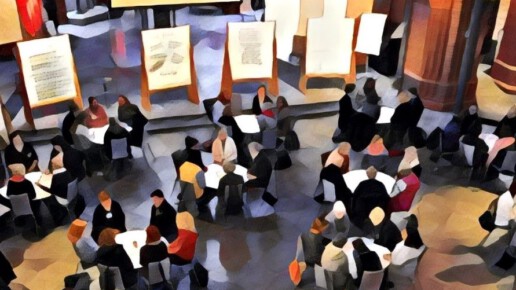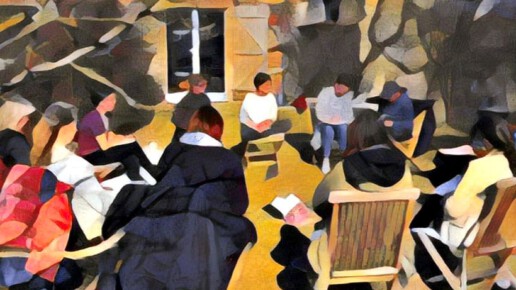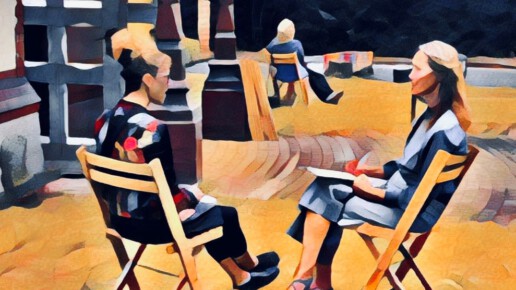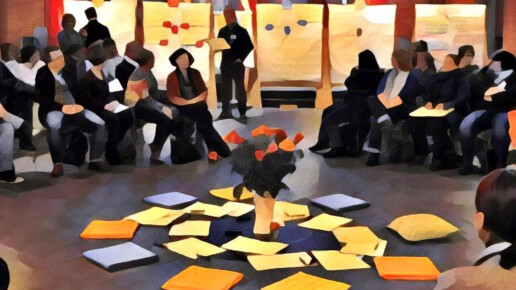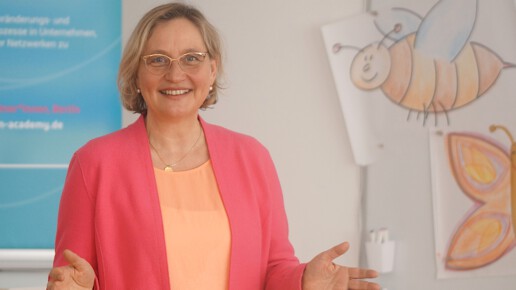*** English version see below ***
3 Entwicklung von ZielenMeine Grundsätze des #Facilitation, 3 von 8
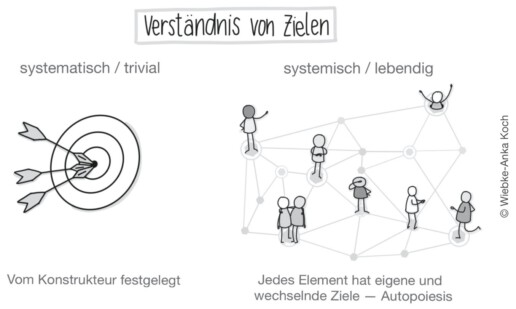
Bei einer Maschine gibt der Konstrukteur das Ziel vor. Ziele müssen spezifisch und quantifizierbar sein, zur Bewältigung der Aufgabe ist ein eindeutiger Geschäftsprozess notwendig, also eine Abfolge von Schritten, die beständig zum gleichen, wiederholbaren und vorhersagbaren Ergebnis führt. So sehr wir diese Sicherheit bei Maschinen, bei Kernkraftwerken oder Krankenhäusern brauchen – in dem Moment, wo Menschen zusammenarbeiten und zusammen »Sinn« erschaffen, ist die Annahme eines eindeutigen Ziels irreführend. Auch in sozialen Systemen ist es Teil der Führungsrolle, Orientierung zu geben und die Menschen auf das Organisationsziel »einzuschwören«. Hierbei wird jedoch oft die Tatsache außer Acht gelassen, dass Menschen nach eigenen Gesetzmäßigkeiten funktionieren und eigene, sogar wechselnde Ziele verfolgen.
Für uns hat sich daher das Konzept der unscharfen Ziele (Gray/Brown/Macanufo 2011) als hilfreich erwiesen. Wenn wir etwas Neues kreieren wollen, wenn die Situation komplex und unvorhersehbar ist, können wir die Ziele nicht von vornherein genau festlegen, da die Gleichung zu viele Unbekannte hat. Wir können jedoch einen Kurs einschlagen in Richtung einer Welt, die wir uns vorstellen und die einen Sinn für uns macht. Hier setzen alle unsere facilitativen Ansätze an: Wir gestalten einen Raum zum Experimentieren, Erkunden und Ausprobieren, in dem sich das Ziel und der Weg zum Ziel immer wieder verändern können.
ESP oder: Wie viel Unschärfe ist optimal? (ebda., S. 5 ff.)
Emotional: Unscharfe Ziele sprechen die Leidenschaft und Energie an.
Sensorisch: Je greifbarer das Ziel, desto leichter kann man es mit anderen teilen. Skizzen und schlichte Modelle erleichtern es, vage Ideen zu konkretisieren und greifbar zu machen.
Progressiv: Unscharfe Ziele sind nicht statisch. Sie können sich verändern, während die Gruppe dazulernt.
Bei der Definition von Zielen geht es darüber hinaus tief in die Frage nach der Ebene der Partizipation hinein. Je nachdem, um was es geht, ist es wichtig, von Anfang an zu klären, ob und wie Menschen im Prozess eingebunden werden sollen. Geht es darum, eine an anderer Stelle bereits definierte neue Unternehmensstrategie mit den Mitarbeitenden zu verfeinern und die Umsetzung zu planen? Oder geht es um einen gemeinsamen Prozess der Suche nach einer zukünftig für die Organisation sinnvollen Zusammenarbeit?
In der Praxis erlebe ich oft, dass das den beteiligten Menschen nicht klar genug ist. Hier findet unsere Praxis der Definition von Zielen und »Leitplanken« Anwendung. Dabei wird immer wieder deutlich, wie wichtig eine präzise Auftragsklärung und ein gut durchdachter Vorbereitungsprozess sind.
In der Entwicklung von Zielen kommt in meiner Praxis eine kleine, aber sehr feine Methodik sehr häufig zur Anwendung: Das kollektive Mindmapping »Der Tag danach« als vorbereitendes Treffen vor dem eigentlichen Workshop.
Das kollektive Mindmapping »Der Tag danach«
Das »Der Tag danach«-Mindmap« habe ich von Michael M. Pannwitz gelernt, ursprünglich entstanden für den Vorbereitungsprozess von Open-Space-Veranstaltungen, nutze ich es heute für jede Art von Workshop. Diese Methode kombiniert den Ansatz der »Wunderfrage« – »Stell dir vor, es ist der Tag nach dem Workshop, du wachst morgens früh auf und merkst: Wow, das war ein wichtiger und sehr guter Prozess … Was ist an dem Tag danach anders, wenn es richtig gut gewesen ist?« – mit dem kollektiven Mindmapping an einer Wand.
In der Anwendung hat es sich bewährt, eine klare Ansage zu machen: »Wenn du einen Impuls hast: aufstehen, hinschreiben, vorlesen und wieder hinsetzen …« Wichtig ist auch, zusammen mit den Teilnehmenden zu warten, bis alle Dinge gesammelt sind. Meine Rolle hierbei ist – wie bei vielen anderen Methoden –, vor allem darauf zu achten, dass das Format eingehalten wird: Wir sammeln und diskutieren nicht. Und zwischendrin lade ich die Teilnehmenden immer wieder ein, alles aufzuschreiben, was ihnen wichtig ist. Und warte ab! Meist entsteht zum Beispiel nach einigen Minuten des eifrigen Aufschreibens eine Pause. Hier mit Geduld und Ruhe darauf zu vertrauen, dass noch mehr kommt, ist entscheidend – denn es kommt mehr!
Ein paar aufmunternde Fragen können helfen. Zum Beispiel sage ich: »Schaut mal … Ist schon alles benannt und geschrieben, das für euch wichtig ist?«
Wie wirkt die Methode?
Die beteiligten Menschen übernehmen Verantwortung für ihre Themen. Ich weigere mich stets, für die Teilnehmenden aufzuschreiben (auch wenn der Raum eng ist und es viel einfacher wäre, wenn ich selbst alles notieren würde).
- Beim Anwenden der Methode wird oft ein emergenter Prozess spürbar. Die Teilnehmenden bauen auf den Aussagen der anderen auf und es entsteht ein gemeinsames Gefühl für den Workshop.
- Es entsteht so etwas wie eine positive »Zieltrance«. Das bedeutet für die Anwesenden: Die Möglichkeit eines positiven und ergebnisreichen Ausgangs des Workshops wird vorstellbarer.
- Die Teilnehmenden erleben meine Art der Begleitung und können sich auch auf dieser Ebene auf den Workshop oder die Konferenz einstellen.
- Die Teilnehmenden und ich bekommen ein differenziertes Gefühl für die offensichtlichen und latenten Themen, um die es bei dem Workshop gehen wird. Nach dem Treffen kann ich meist sehr viel genauer planen.
Das Mindmap in dieser Form kann natürlich für jede Art von Planung genutzt werden. Eine Projektleiterin schrieb mir über ihre Erfahrungen: »Ich war zunächst nicht überzeugt davon, ob die Mindmap-Methode so gut funktioniert. Sie schien mir zu unstrukturiert. Und dann habe ich sie während einer Teamsitzung ausprobiert und war völlig überrascht, dass sich wirklich alle beteiligt haben, selbst Personen, die sonst nie etwas beitragen. In dem Moment habe ich die Kraft gespürt, die in dieser Methode liegt. Seitdem nutze ich das kollektive Mindmapping immer dann, wenn ich ein neues Projekt plane.«
In unserer eigenen Konzeption von Prozessen und in der Kommunikation mit unseren Auftraggeberinnen und Auftraggebern nutze ich gern das Modell »Art of Harvesting«.
Art of Harvesting
»Art of Harvesting« ist ein Ansatz der »Art of Hosting«-Community. Das hier vorgestellte Modell wurde erstmals von Chris Corrigan veröffentlicht: http://www.chriscorrigan.com/parkinglot/.
»Harvesting« beschreibt den Prozess der »Ernte«, also des Zusammenfassens und Sicherstellens der Ergebnisse eines Treffens oder Prozesses. Hierbei hilft ein breiter Blick durch verschiedene »Brillen« dabei, neben den unmittelbaren kollektiven Ergebnissen (ein Plan, eine Entscheidung oder eine Ideensammlung) auch individuelle und nicht greifbare Ergebnisse und Wirkungen beschreibbar zu machen.
Wir können dieses kleine Modell für die Auftragsklärung nutzen (Was wünschen wir uns als Ernte in den einzelnen Quadranten?) oder wir können beispielsweise zum Abschluss eines Workshops die vier Quadranten von den Teilnehmenden füllen lassen.
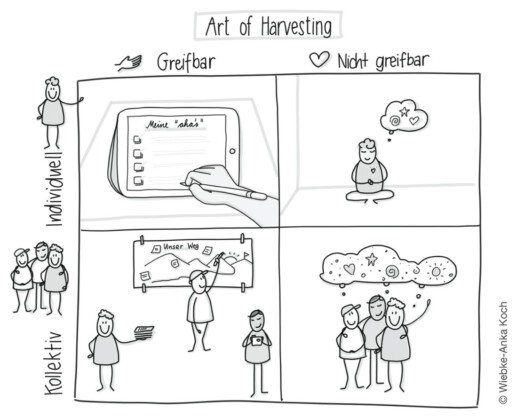
Mehr zu den Grundsätzen des Facilitation in meinem „Mini Handbuch Facilitation“, Beltz-Verlag 2021, oder in unseren Ausbildungsangeboten auf www.facilitation-academy.de
Wir möchten besonders auf unsere folgenden Ausbildungsangebote hinweisen:
1-jährige Ausbildung zum Facilitator
Seminar Interne Prozessbegleitung
Facilitation Basics Online
© Jutta Weimar – Dieser Text ist urheberrechtlich geschützt. Leicht veränderter Auszug aus dem Buch „Mini-Handbuch Facilitation“, erschienen 2021 beim Beltz Verlag. Alle Rechte vorbehalten. Mehr Informationen zu Facilitation unter: www.facilitation-academy.de
*** English Version ***
3 Development of goalsMy principles of #Facilitation 3 of 8.
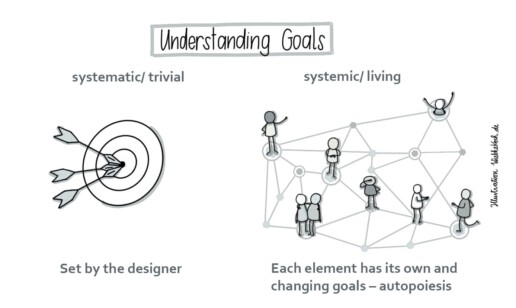
In the case of a machine, the designer sets the goal. Goals must be specific and quantifiable; to accomplish the task, a clear business process is required, that is a sequence of steps that consistently leads to the same, repeatable and predictable result. As much as we need this certainty in machines, in nuclear power plants or hospitals – the moment people work together and create „meaning“ together, the assumption of a clear goal is misleading. In social systems, too, part of the leadership role is to provide orientation and to „swear“ people to the organizational goal. However, this often ignores the fact that people function according to their own laws and pursue their own, even changing goals.
For us, therefore, the concept of fuzzy goals (Gray/Brown/Macanufo 2011) has proven as helpful. When we want to create something new, when the situation is complex and unpredictable, we cannot set the goals precisely from the start, because the equation has too many unknowns. We can, however, chart a course toward a world which we envision as making sense to us. This is where all our facilitative approaches come in: We design a space for experimentation, exploration, and trial and error, where the destination and the path to the destination can always change.
ESP or: How much blurring is optimal? (Gray/Brown/Macanufo 2011, p. 5 ff.)
Emotional: fuzzy goals appeal to passion and energy.
Sensory: The more tangible the goal, the easier it is to share it with others. Sketches and simple models make it easier to concretize vague ideas and make them tangible.
Progressive: Vague goals are not static. They can change as the group learns.
Furthermore, in defining goals, it goes deeply into the question of the level of participation. Depending on what is at stake, it is important to clarify from the beginning whether and how people should be involved in the process. Is it about refining a new corporate strategy that has already been defined elsewhere with employees and planning its implementation? Or is it about a joint process of finding a way of working together that will make sense for the organization in the future?
In practice, I often experience that this is not clear enough to the people involved. This is where our practice of defining goals and „guard rails“ comes in. Again and again, it becomes clear how important a precise clarification of the task and a well thought-out preparatory process are.
In the development of goals, a small, but very fine methodology is used very often in my practice: The collective mindmapping „The Day After“ as a preparatory meeting before the actual workshop.
The collective mindmapping „The Day After“.
I learned the „The Day After“ mind map from Michael M. Pannwitz; originally created for the preparation process of Open Space events, I do now use it for any kind of workshop.
This method combines the „wonder question“ approach – „Imagine it’s the day after the workshop, you wake up early in the morning and realize: wow, that was an important and very good process … What’s different the day after, if it was really good?“ – with the collective mind mapping on a wall.
In the application, it has proven useful to make a clear announcement: „If you have an impulse: stand up, write down, read out and sit down again …“ It is also important to wait together with the participants until all things are collected. My role here – as with many other methods – is to make sure, above all, that the format is followed: We collect and do not discuss. And in between, I invite the participants again and again to write down everything that is important to them. And wait! Usually, after a few minutes of eager writing down, there is a pause. Trusting here, with patience and calm, that there will come more, is crucial – because there is coming more!
A few encouraging questions can help. For example, I say, „Look … Has everything that is important to you already been named and written down?“
How does the method work?
– The people involved take responsibility for their issues. I always refuse to write things down for the participants (even though space is tight and it would be much easier, if I wrote everything down myself).
– When using the method, an emergent process is often felt. Participants build on what others have said, and a shared sense of the workshop emerges.
– Something like a positive „goal trance“ emerges. This means for those present: The possibility of a positive and fruitful outcome of the workshop becomes more imaginable.
– The participants experience my kind of accompaniment and can also adjust to the workshop or conference on this level.
– The participants and I get a differentiated feeling for the obvious and latent issues that the workshop will be about. After the meeting, I can usually plan much more precisely.
The mind map in this form can of course be used for any kind of planning. One project manager wrote to me about her experience: „I was not convinced at first, whether the mind map method works so well. It seemed too unstructured to me. And then I tried it out during a team meeting and was completely surprised that everyone really participated, even people who usually never contribute. At that moment I felt the power that lies in this method. Since then, I use collective mind mapping whenever I plan a new project.“
In our own design of processes and in communication with our clients, I like to use the „Art of Harvesting“ model.
Art of Harvesting
„Art of Harvesting“ is an approach used by the „Art of Hosting“ community. The model presented here was first published by Chris Corrigan: http://www.chriscorrigan.com/parkinglot/.
„Harvesting“ describes the process of „harvesting“, that is, summarizing and securing the results of a meeting or process. Here, a broad view through different „glasses“ helps to make individual and intangible outcomes and impacts describable in addition to the immediate collective outcomes (a plan, a decision, or a collection of ideas).
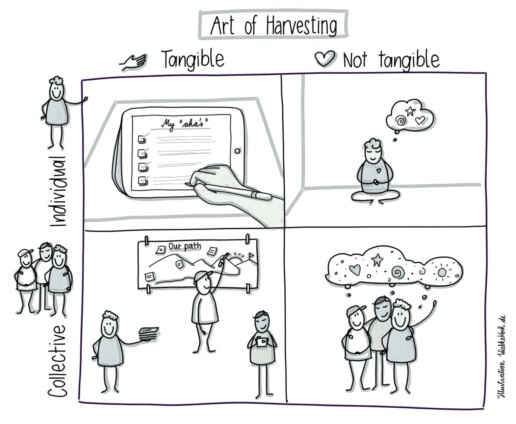
We can use this small model for mission clarification (What do we want as a harvest in each quadrant?) or, for example, we can have participants fill in the four quadrants at the conclusion of a workshop.
_____________
More about the principles and practice of facilitation in my „Mini Handbuch Facilitation“, published 2021 by Beltz-Verlag, or in our training offers on www.facilitation-academy.de
Join us in our Facilitation Trainings (in German):
1 year Facilitation Training
Inhouse Facilitator
Facilitation Basics Online


